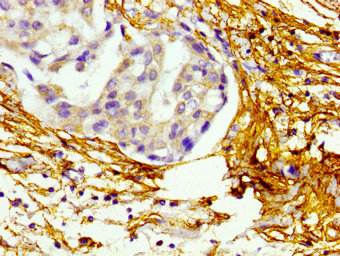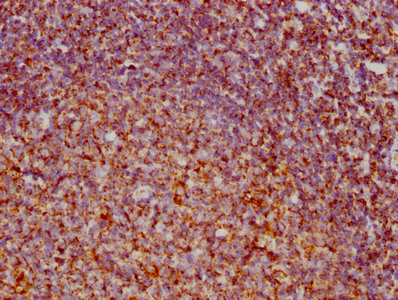BMP10 Antibody
-
货号:CSB-PA002734LA01HU
-
规格:¥440
-
促销:
-
图片:
-
其他:
产品详情
-
产品名称:Rabbit anti-Homo sapiens (Human) BMP10 Polyclonal antibody
-
Uniprot No.:O95393
-
基因名:BMP10
-
别名:BMP-10 antibody; Bmp10 antibody; BMP10_HUMAN antibody; Bone morphogenetic protein 10 antibody; Bone morphogenetic protein 10 preproprotein antibody; MGC126783 antibody; OTTHUMP00000159973 antibody
-
宿主:Rabbit
-
反应种属:Human
-
免疫原:Recombinant Human Bone morphogenetic protein 10 protein (317-424AA)
-
免疫原种属:Homo sapiens (Human)
-
标记方式:Non-conjugated
本页面中的产品,BMP10 Antibody (CSB-PA002734LA01HU),的标记方式是Non-conjugated。对于BMP10 Antibody,我们还提供其他标记。见下表:
-
克隆类型:Polyclonal
-
抗体亚型:IgG
-
纯化方式:>95%, Protein G purified
-
浓度:It differs from different batches. Please contact us to confirm it.
-
保存缓冲液:Preservative: 0.03% Proclin 300
Constituents: 50% Glycerol, 0.01M PBS, pH 7.4 -
产品提供形式:Liquid
-
应用范围:ELISA, IHC
-
推荐稀释比:
Application Recommended Dilution IHC 1:20-1:200 -
Protocols:
-
储存条件:Upon receipt, store at -20°C or -80°C. Avoid repeated freeze.
-
货期:Basically, we can dispatch the products out in 1-3 working days after receiving your orders. Delivery time maybe differs from different purchasing way or location, please kindly consult your local distributors for specific delivery time.
相关产品
靶点详情
-
功能:Required for maintaining the proliferative activity of embryonic cardiomyocytes by preventing premature activation of the negative cell cycle regulator CDKN1C/p57KIP and maintaining the required expression levels of cardiogenic factors such as MEF2C and NKX2-5. Acts as a ligand for ACVRL1/ALK1, BMPR1A/ALK3 and BMPR1B/ALK6, leading to activation of SMAD1, SMAD5 and SMAD8 transcription factors. Inhibits endothelial cell migration and growth. May reduce cell migration and cell matrix adhesion in breast cancer cell lines.
-
基因功能参考文献:
- Data suggest BMP9/GDF2 and BMP10 synergize with TNFA to increase monocyte recruitment to vascular endothelial cells; process appears to be mediated mainly via ALK2/ACVR1 (which exhibits protein kinase activity). These studies used in vitro flow monocyte adhesion assay. (BMP9 = growth differentiation factor 2; BMP10 = bone morphogenetic protein 10; TNFA = tumor necrosis factor alpha; ALK2/ACVR1 = activin A receptor type 1) PMID: 28646109
- Bone morphogenetic protein (BMP)9 and BMP10 are high affinity ligands for activin receptor-like kinase 1 (ALK1). PMID: 27528761
- Forced expression of BMP10 in gastric cancer (GC) cells inhibited its growth and migration, while knocking down the expression of BMP10 in GC cells promoted cell growth, migration, and metastasis. PMID: 26419594
- The Prodomain-bound Form of Bone Morphogenetic Protein 10 Is Biologically Active on Endothelial Cells. PMID: 26631724
- BMP10, is elevated in the stenotic colon segment of Hirschsprung disease patients, and BMP10 signaling may play a pivotal role in disease development. PMID: 24551273
- Low expression of bone morphogenetic protein-10 is associated with urothelial cancer of the bladder. PMID: 23645739
- Soluble endoglin specifically binds bone morphogenetic proteins 9 and 10 via its orphan domain, inhibits blood vessel formation, and suppresses tumor growth. PMID: 21737454
- Furin is the major processing enzyme of the cardiac-specific growth factor bone morphogenetic protein 10. PMID: 21550985
- Bone morphogenetic protein-10 (BMP-10) may function as a tumor suppressor in breast cancer. PMID: 20608934
- Hypertension induced expression of prohypertrophic BMP10, and the hypertrophic effect of BMP10 was modulated, at least in part, by its binding to Tcap at the Z disc. PMID: 17921333
- Describes the cloning and expression of murine BMP-10. PMID: 10072785
显示更多
收起更多
-
亚细胞定位:Secreted.
-
蛋白家族:TGF-beta family
-
组织特异性:Detected in mammary epithelia (at protein level).
-
数据库链接:
HGNC: 20869
OMIM: 608748
KEGG: hsa:27302
STRING: 9606.ENSP00000295379
UniGene: Hs.158317
Most popular with customers
-
YWHAB Recombinant Monoclonal Antibody
Applications: ELISA, WB, IF, FC
Species Reactivity: Human, Mouse, Rat
-
-
-
-
-
-
-
VDAC1 Recombinant Monoclonal Antibody
Applications: ELISA, WB, IHC
Species Reactivity: Human, Mouse, Rat






















